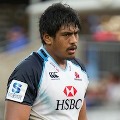
 Super Rugby is regarded in the Southern Hemisphere as the elite stepping stone towards Test rugby, and while the penultimate year before a Rugby World Cup is rarely considered as an experimentally season, future development and injuries will likely dictate some new faces will appear.
Super Rugby is regarded in the Southern Hemisphere as the elite stepping stone towards Test rugby, and while the penultimate year before a Rugby World Cup is rarely considered as an experimentally season, future development and injuries will likely dictate some new faces will appear.
We run the rule over the players who could be heading for the highest honour their national union can bestow upon them.
The All Blacks, Springboks and Wallabies will reveal their final June squads at the conclusion of Super Rugby Round 16.
sanzarrugby
Malakai Fekitoa

Malakai Fekitoa
The happiest player watching the growth of Fekitoa would be team-mate Ben Smith. The Highlanders captain ‘filled in’ for All Blacks first choice centre Conrad Smith during the World Champions end of year campaign.
It wasn’t a failure per say, but this season of Super Rugby has shown that Ben’s best skills are on display when stationed in the outside three-quarter line.
The absolute class of Conrad and Ma’a Nonu, and the impending return of Sonny Bill Williams, means New Zealand isn’t wanting for midfield operators, but most pleasing is that 22-year-old Fekitoa is, by Kiwi measures, a baby when it comes to centres.
Legends like Frank Bunce, through to more recent operators like Tana Umaga and Nonu, have taken years to reach their finest vintage.
Simply put, Fekitoa is among the South’s best centres, the finest statistical performer.
With 48 beaten defenders, leading the competition, and more carries (124) and metres (701) than any other midfielder, the Tongan born 100kg powerhouse possesses the sort of x-factor the All Blacks love, and Steve Hansen hasn’t been shy to confirm his new centres likely inclusion in the final squad.
Damian de Allende

Damian de Allende
Another 22-year-old, the Cape Town born centre is second only to Fekitoa when looking through the statistics of Super Rugby’s middle of the field men.
In a sporting world where other codes prey voraciously on prodigies, it was cricket, not rugby, where a young de Allende excelled when attending Milnerton High School, however Western Province’s academy systems are among the finest in the Republic.
He was quickly integrated into the vaunted age grade teams, he made the Under-19 WP side, playing alongside Eben Etzebeth (who already boasts 23 Test caps).
As an attacking spearhead de Allende is only getting better, he boasts the exact same metre per gain rate (5.65) as his counterpart Fekitoa in the Deep South, and has added utility value, half of his appearances for the Stormers have been at 12 – but stints on the wing and off the bench as backline cover have by the words of the man himself enabled him to learn more about the nuances of the game.
An injury to South African skipper Jean De Villiers have only firmed the chances of his introduction onto rugby’s highest stage.
Will Skelton

Will Skelton
As a young boy Will Skelton, who initially preferred playing league to union, used to gather balls up at Blues training sessions, watching cousin Brad Mika play, and this connection almost led to Graham Henry poaching the giant to Auckland.
A shift to Sydney when he was 10, eventually yielded a call up to the Sydney University Rugby team, then the Australian Rugby Union’s national academy, before making his debut for the Waratahs in 2013 despite initially being named as a ‘wider training group’ member.
One of Super Rugby’s biggest players at 2.03m tall and, pending on the variances of the scales, 135-140kg, Skelton has already shown glimpses of his immense talent, even if some purists of second row play believe he still plays with too much looseness at this stage.
While the big lock might relish using his frame to run, a la league style, into opposition defences, over the weeks he is playing more minutes and discovering a remarkably soft pair of hands for such a behemoth.
The Wallabies are often said to lack sheer physical menace when compared to their SANZAR counterparts – Skelton will tip these scales literally if he enters the international arena.
Liam Coltman

Liam Coltman
There will be a new All Blacks hooker in the coming weeks, it is the major work on position for the likes of Steve Hansen and co, and there are only two capped rakes available to the selectors in Keven Mealamu and Dane Coles.
Nathan Harris is the other uncapped hooker called into the All Blacks recent wider training group, but the Chiefs number two is considered something of a left field selection.
Coltman meanwhile, who all but ousted Andrew Hore as the number one Highlanders hooker late last year, was the first name announced as the All Blacks last year initiated their ‘hooker apprenticeship’ scheme.
A former prop, Coltman’s work around the park and in the scrum is notable, although he has admitted the lineout throwing is still a work in progress (77%), as it is with Harris (83%).
Marnitz Boshoff

Marnitz Boshoff
While Morne Steyn is likely to again be plucked from Europe, the inclusion of Lions sniper Marnitz is notable for the fact that his running game is better than he is given credit for, but this is likely because his boot looks destined for Test rugby.
Forty-eight successful kicks with an 87% kicking percentage, plenty from long range, is backed by one of the best ball in hand attacking approaches of any of Super Rugby’s first five-eighth.
Only Beauden Barrett, Bernard Foley and Quade Cooper boast better running numbers.
While this is the 25-year-old’s first full year of Super Rugby, experience with the Blue Bulls, Griquas and the Golden Lions has meant that Boshoff has looked a player beyond his years and with a similarly conservative approach that the Springboks prefer, his appeal to Heyneke Meyer is obvious.